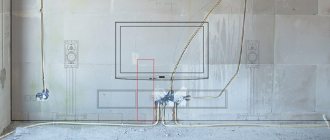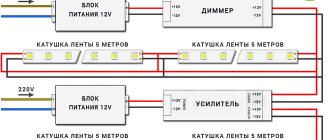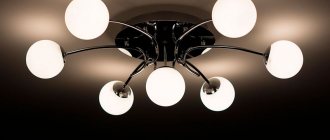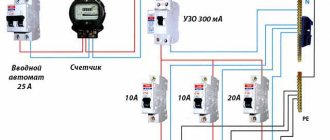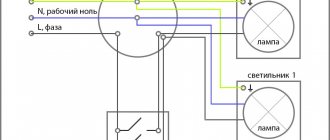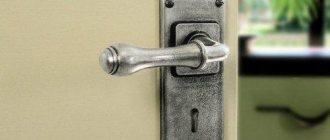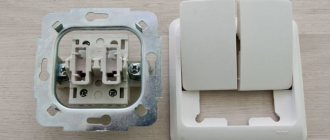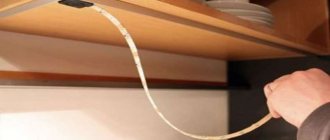Application in terminal block circuits
Terminal blocks are electrical products made of non-conducting material, inside of which a conductive sleeve is inserted, which has a pair of screws at opposite ends. They serve to secure the wire. An excellent choice for implementing a modern way of connecting wires.
Types of terminals for connecting wires
When choosing a reliable connection of wires, it is important to remember: terminal blocks are produced with different holes for many cross-sections.
This method is almost always used for connections in junction boxes of any type, during installation, installation of wall and other lamps. It is suitable for mounting most devices, switches and sockets. It is easy to mount a network using such fittings; you just need to insert the bare ends into the holes and, using moderate force, securely tighten the screws. The wire itself should not be crushed. Having figured out how to properly connect electrical wires using terminals, it is worth exploring other equally reliable methods.
Connecting the wire with a screw clamp
Evaluation of the terminal method: Excellent quality of fastening. Their prices are reasonable. Quite quick and easy installation. A good opportunity to connect different conductors, for example, aluminum and copper.
Sometimes the terminal blocks themselves are sold in poor quality, which threatens to break them during installation. Possibility of connecting no more than two cables of the same section into one socket. Be sure to read how to correctly connect wires by color.
It is not recommended to connect aluminum and stranded circuits with blocks. This is due to the high fragility of aluminum wires and the great flexibility of the stranded wire conductors themselves. But overall a decent method.
Types of electrical connection blocks
Devices for switching wiring are selected depending on the purpose. Among the many models, the best option is selected. There are several ways to fix conductors in blocks.
Spring
Spring terminal device
A common version of spring-type products is self-clamping terminals. They are disposable and reusable. In the first case, after fastening, the wire cannot be pulled out without significant damage. In reusable models, it is released using a lever. Advantages of the method:
- installation does not require experience or tools;
- the stripped end of the wire is fixed with a spring after insertion into the groove;
- The connection is reliable and durable.
Spring-loaded copper contact plates secure stranded wires without damage. The quality of the wiring connection does not depend on the professionalism of the technician. Even a beginner can easily handle the self-clamping mechanism. The leader in the production of devices with automatic contact clamping is the German company WAGO. The disadvantage is the high cost of the products.
Screw
Screw terminal
Screw connectors hold the wire to the pad using screw pressure. The metal clamp is housed in a plastic housing. Advantages of switches:
- possibility of reuse;
- the block consists of many parts;
- installation is carried out with one screwdriver.
Disadvantages of screw pads:
- sensitivity to vibration;
- not recommended for aluminum cable;
- Regular maintenance (tightening of screws) is required.
Screw type terminal blocks are not suitable for multi-core wires. It is recommended for single-core copper cable. When tightening the screws, a certain amount of force is required; experience is required to perform the connections correctly. Well-known manufacturers of screw switches are Legrand and Wiedmuller.
Knife type
Blade terminal
Knife-type switches are installed in the circuits of the grounding system. They are recommended in areas where the wire is not cut for safety reasons. Their feature is that there is no need to remove insulation from the contact. The wire is inserted into the terminal block, where a special knife cuts through the braid and securely fixes the core. This type of connector has its advantages:
- installation is accelerated;
- compact dimensions;
- No professional skills required for installation.
Knife terminal blocks are not used for power circuits; most often they are used to connect audio equipment.
Terminals on plastic blocks
The terminals are used to connect two wires. They come with different hole diameters for the conductive core. The devices allow you to connect cables with one or more cores, conductors of various cross-sections. The design of the pads eliminates oxidation processes when connecting wires made of copper and aluminum. Some models are filled with a paste that prevents corrosion. A special recess in the plastic prevents pressure on the core when tightening the screw. The transparent body of the products makes it possible to assess the condition of the contacts.
Terminals for connecting wires
Ring terminal
Common crimp terminal designs for wiring include:
- Ring - round-shaped clamps are characterized by the most reliable contact due to the large contact area. They are recommended for low-current and power networks. The products consist of a metal ring and a shank. The terminals are made of copper or aluminum. Product sizes are presented in the range of 3-27 mm.
- Pin - detachable parts consisting of two parts - a plug and a socket. These are isolated devices whose color indicates the power of the terminal block. The connection parts are marked with the symbols “A” and “B”.
- Fork type – fork type terminals are designed for screw mounting. They are used in secondary and power circuits. The materials for the products are aluminum, brass and various copper alloys. Structurally, the clamps are a two-prong plug, with or without insulation. Suitable for wires not exceeding 6 mm in diameter.
- Knife wires are a common option for multi-core wires of small cross-section. The terminals are used for household appliances - irons, refrigerators. The design of the products is paired “father and mother”. The color of the insulation depends on the power, the maximum parameter is 5 kW.
Using terminals is the simplest and most economical option for switching electrical wires.
Walnut Branch Clamps
Nut for connecting wires
The main branch branch clamp without division consists of a plastic body and metal plates with bolts. The dies have grooves for contacts. When choosing a model, take into account the cross-section of the main wire and branches. This connector can be used to connect aluminum and copper wires. Between the two dies there is a brass separating plate.
For distribution boxes
The wires of all connected devices are brought into the distribution box. Terminal blocks for junction boxes are designed for branching electrical wiring. Their body is made of polycarbonate, and the contact pad is made of copper. Fixation is carried out by a spring mechanism.
With fuse
The devices have an additional element in their design - a fuse. The terminals are oversized. They are installed in DC and AC networks. Scope of application – switching electrical appliances without built-in fuses and installation in a panel on a DIN rail.
Spring terminals
Quick installation of electrical networks is sometimes simply necessary. For example, install temporary lighting on a balcony, terrace, gazebo. Wago spring terminals are an excellent product for such work. A modern and of course reliable way to connect wires. Although they are new to the electrical accessories market, installation using spring terminals is quick and, importantly, convenient.
Vago clamping terminals
The main difference between the use of the Vago terminal blocks themselves: they are more convenient to connect any wires in electrical boxes than with twisting. Here, for high-quality installation, a unique clamping mechanism is used, rather than a simple screw. Manufacturers produce both disposable and reusable vagon systems.
- In the usual version, this product is used for one-time use; during repair work in the future it cannot be restored. It is removed and a new one is installed in its place.
- Wago reusable terminals are a little more expensive, but with their help you can disconnect the assembled contacts several times, rewiring the circuit to suit your needs. This speeds up the process of repairing or installing permanent and temporary networks. A simple lever-type mechanism provides the advantage that it is possible to carefully but efficiently fix any wire without damaging or squeezing it.
With the help of a vault, it’s easy to do the fastening yourself; you just need to strip the insulation and insert the required wires into the mounting hole. Press the lever. It is important to correctly calculate the load on the wires using an online calculator.
Evaluation of the wago clamping system: Unique ability to combine any aluminum, copper and other conductors. There is an option for connecting multi-core cables simultaneously (two or more).
Wago universal clamps allow you to fix any thin stranded conductor without damaging it. Another plus is the compact size of the pads.
Wago self-clamping terminals
Excellent quality and durability. The Vago type block has a technological hole that provides access for a screwdriver with a voltage indicator. The operation of any power line can be checked at any time. Perhaps one drawback is the considerable cost of the terminals themselves. But this type of wire connection is the most modern and fastest.
Isolation with PPE caps
Deciphering the product is not difficult, connecting insulating clips (PPE). They are ordinary nylon or plastic caps with an internal lock.
Connection with PPE caps
The simplest type of connection of wires, it is carried out after twisting the conductors themselves, the cores. Caps are often used to connect wires in junction boxes and to mark connections with the desired color.
Assessment of the use of such products: Quite low cost of PPE. The use of safe material prevents ignition of electrical wiring. Easy installation, put it on a twist of wires and you're done. These caps have a wide range of colors, which is convenient. Of course, if the wires are not color coded, colored PPE has the ability to determine or simply mark zero, phase and other necessary electrical routes.
There are also disadvantages: Insufficient level of fixation. Multicore wires can be installed only after soldering.
PPE caps
The caps are also called connecting insulating clips (abbreviated as PPE).
Design
The outside of the cap body is made of plastic. This material has a number of positive aspects:
- under the influence of open fire does not support the combustion process;
- able to withstand operating voltages up to 600 V;
- has good insulating properties.
The plastic case, in addition to insulating the connection point, also protects it from mechanical damage.
Inside the cap is equipped with a compression spring made of steel and shaped like a cone. When a wire twist is inserted into the cap, the coils of this spring further compress it.
When using caps, it is very important to properly trim the ends for twisting. The insulating layer must be cut off so much so that the bare metal is not outside the cap, but completely falls under the compression spring.
Preparing wires for caps
Now in the electrical world it is already considered a mistake to expose a wire or cable from the insulating layer with a knife. Professional electricians use special devices - insulation strippers.
This device has calibrated holes for each standard core diameter (the holes have a cutting edge). The insulation stripper does not disturb the conductive surface layer, which maintains its strength.
No one can cancel the mechanic's knife either. The main thing is to position it when removing insulation towards the cutting direction at an angle, so as not to catch the metal core. Positioning the knife at a right angle while removing the insulating layer is not allowed, since there is a high probability that you will make a circular cut, as a result of which the core may then break.
When choosing PPE caps, special attention should be paid to the size of the crimp springs. The main contact is created in its smallest conical part. It is very important that it matches the wires being connected. If the wires are thin, the compression with a cone spring will not be tight, and thick twisted wires, on the contrary, will not fully enter the cap.
Core connection
Connecting wires using PPE caps is done in practice in two ways:
- No pre-twisting. Two wires of equal diameter must be inserted forcefully into the spring. Then vigorously rotate the cap in a clockwise direction. In this way, twisting is done to the length of the bare metal strands of the wires.
- If it is necessary to connect three or four wires, they must first be twisted using pliers, the twisted end must be bitten off, and then the cap must be put on, turning it clockwise with force.
Remember! In order for the PPE cap to fit tightly onto the surface of the twist, it must be rotated only clockwise, but not in the opposite direction.
Put the cap on with force so that the coils of the crimp spring move apart and reliably compress the connected wires.
Never use PPE caps to connect wires of different materials. This applies to a greater extent to copper and aluminum, between which the passage of electric current causes a galvanic process.
How to connect with caps is shown in this video:
Types of caps
Many electricians have a negative attitude towards PPE caps. But this attitude can be caused by two reasons. Either the caps were chosen incorrectly, or they were ineptly installed on the wires being connected.
In order to correctly select caps for wire sizes, manufacturers have introduced special color markings:
- SIZ-1 – connects two wires with a cross-section of 1.5 mm2 (gray);
- SIZ-2 – connects three wires with a cross-section of 1.5 mm2 (blue);
- SIZ-3 – connects two wires with a cross-section of 2.5 mm2 (orange);
- SIZ-4 – connects four wires with a cross-section of 2.5 mm2 (yellow);
- SIZ-5 – connects eight cores with a cross section of 2.5 mm2 (red).
However, there are no uniform international standards for such color marking. Therefore, it may differ for manufacturers from different countries. Be careful when purchasing, check with your sales consultant for the required sizes.
Installation of networks using sleeves
This option claims to be the most reliable connection method. Any load and quality of wires.
Crimping wires with sleeves
The conductive wires are inserted into a special tube - a sleeve, and crimped with a certain force. There is one thing, but. The cross-section of the wires should not exceed the cross-section of the mounted sleeves. Having inserted and crimped the clip, the sleeve is carefully insulated with heat-shrinkable tubing or other insulating materials.
Overall rating. A great way to securely connect wires. The direction of the conductors can be on different sides of the tube or on one side. The sleeves are quite inexpensive. A good way to reliably connect wires to each other.
There are also disadvantages. Disposable use of sleeves, they are not dismountable. To carry out such work you will need a tool: pressing pliers, which are also used as a special tool. They remove the insulation. They have a crimping device in their arsenal, and electrical installation work takes a little longer.
How to connect wires in a junction box
Let's assume that you are a bit of an electrician and decide to install or replace the wiring in your own house or apartment yourself. But if you don’t know any other way than to connect the wires in the junction box using simple twisting, we recommend that you familiarize yourself with this material. After all, there are many methods for reliable joining of contacts: welding, soldering, crimping, as well as the use of electrical connectors. Each of the options must be applied correctly and in the right place.
Soldering or welding wires
This method is reliable. Typically, this method of connection in a junction box involves first stripping and twisting the ends, after which they are dipped into heated solder. It is advisable to connect aluminum to aluminum wires by soldering. They are then insulated using a heat pipe or insulating tape.
Method of twisting wires
It is strictly not recommended to immediately cool soldered wires in water; microcracks that occur with this type of cooling affect the quality of the connection. They don't last long.
Evaluation of the soldering method. It provides strong circuit contacts and excellent quality, is not expensive, and is the most reliable method of connecting electrical wires in a soldered box.
Technological disadvantage. You can't do this without a soldering iron. The speed of work is not high. The connection is naturally not detachable. It follows from this that soldering is done in extreme cases, using more modern connection methods. It has not been popular among masters for a long time because it takes more time.
There is also a less common method for connecting electrical wires, welding. The process is similar, but requires the use of a special welding machine, of course, and certain skills.
Contact twisting method
Not a new, one might say “old-fashioned” method, it consists of spiral twisting of the cores among themselves. The essence of all work is to twist the stripped conductors using pliers, and cover the twisted area with insulation. These are, perhaps, all the ways to twist wires.
Reliable ways to twist wires
Evaluation of this connection method. High speed of all installation work. The cost part is minimal.
Flaw. It is forbidden to connect together strands of different compositions, copper and aluminum wires, oxidation is inevitable. According to the regulatory framework, fastening wires with twists in a junction box is not recommended for use in rooms with flammable materials, high humidity, basements, or in any house built of wood. Learn more about the method of twisting electrical wires. I definitely recommend watching a video about which is better: twisting or Vago terminal blocks.
Pros and cons of a junction box
Let's move on to the positive and negative points that will show the appropriateness of the junction box:
- free access to the connection point of the wires. For example, if a socket or switch malfunctions, you can easily find the non-functioning section of the circuit. This will allow you not to violate the integrity of wallpaper, plaster and other surfaces when twisting is achieved;
- anticipating the need for additional sockets (you can easily increase the number of connectors, unlike parallel connections);
- reliable and correct connection of wires in the junction box - connection using terminals (there is enough space in the junction box to accommodate various terminals, which would take up significant space in the wall);
- relatively high level of fire safety;
- violation of the harmony of the interior (the thickness of the wall may not allow installing the box inside, so you will have to install it in an overhead way);
- a cheaper method than running a separate cable to each outlet or switch.
wiring diagram for connecting wires in a junction box using twisting
As you can see, the junction box is a means that ensures high-quality operation of electrical appliances.
Important: before working with wiring, be sure to turn off the power supply at the switch. Inform everyone in the house orally and in writing (by hanging an appropriate sign on the switch) that work is being done with electricity and do not touch the switch.
Wire clamp "walnut"
Such a device is simply a cable clamp that has two plates inside and several screws for tightening, usually in the corners. It is enough to screw the wires to the plate itself. Then put a carbolite shell on top.
Clip called Walnut
Grade. An excellent option for connecting any electrical wires in a large and medium-sized junction box. Definitely, these types of products are quite convenient and have a high degree of protection. Makes it possible to quickly connect a wire to a thick gauge track without tearing it.
Flaws. Dimensions allow installation only in spacious distribution boxes and switchboards. Over time, the screws loosen.
Tip: When choosing fittings and method, remember the following:
- It is necessary to work only with isolated tools and use protective equipment.
- Be sure to post a “do not turn on” warning sign on the shutdown panel or meter.
- Connect electrical appliances according to the attached instructions.
Having considered the main types of wire connections, you can easily select the right option. And having a simple tool and a diagram at hand, you can mount it yourself. Learn more about how to install an electrical panel correctly.
